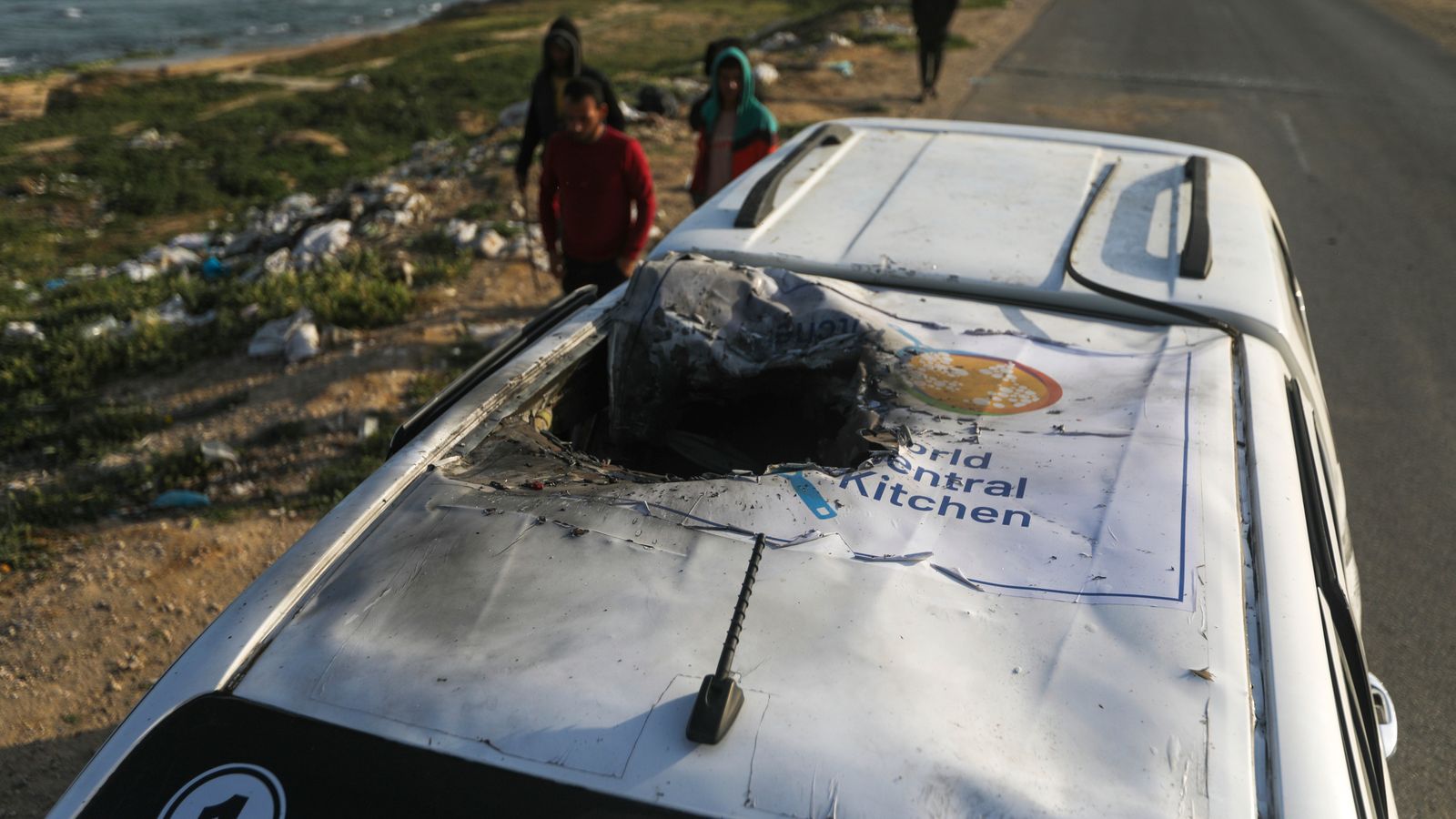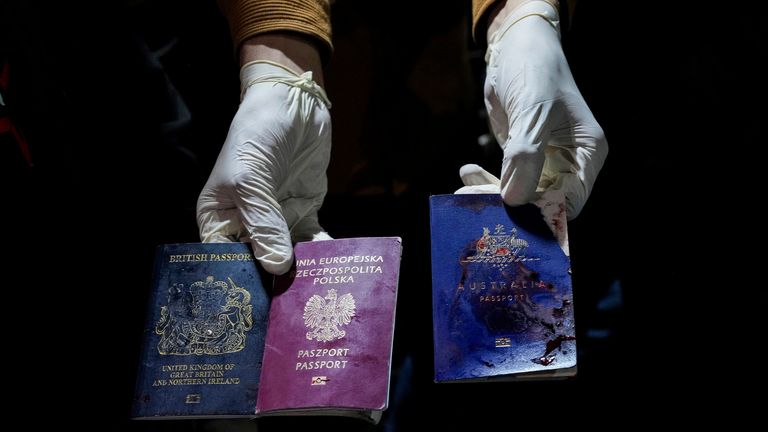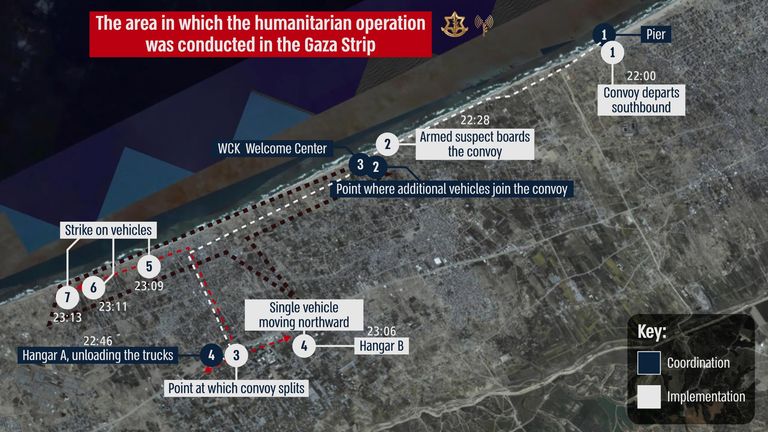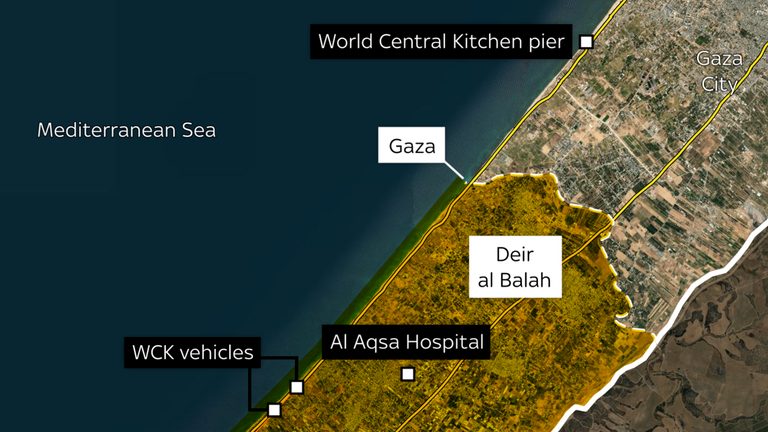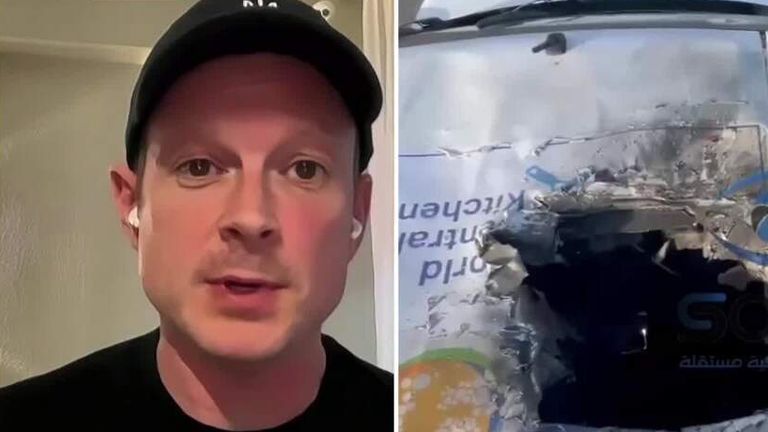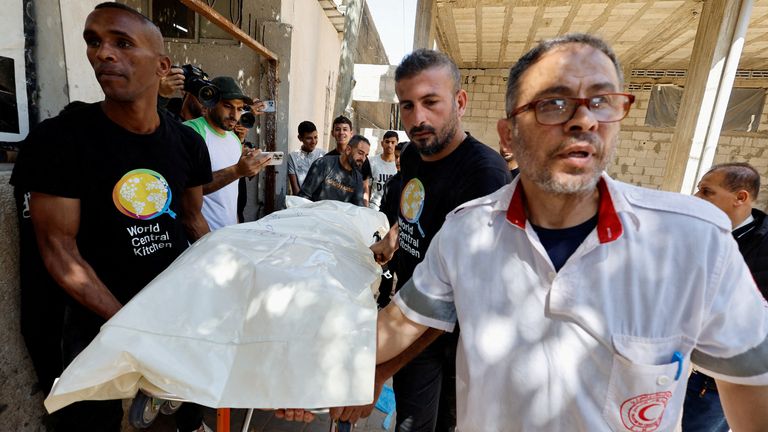The first strike was a case of false identity; the second and then the third were “grave mistakes”.
An Israeli investigation into the killing of seven aid workers, which has drawn outrage around the world, has found that incorrect assumptions, decision-making mistakes and violations of the rules of engagement had resulted in their deaths.
“The investigation’s findings indicate that the incident should not have occurred,” the IDF has said.
“The strike on the aid vehicles is a grave mistake stemming from a serious failure due to a mistaken identification, errors in decision-making, and an attack contrary to the Standard Operating Procedures.”
Follow live: Israel to open new routes for humanitarian aid
Three Britons – John Chapman, James Henderson and James Kirby – were killed in a series of airstrikes. They died alongside their colleagues, 35-year-old Damian Sobol from Poland, Australian Zomi Franckom, dual US-Canadian national Jacob Flickinger, and their young Palestinian driver Saifeddin Issam Ayad Abutaha.
Under extreme pressure to explain why they killed the seven innocent aid workers, the Israeli military has released interim findings after a 72-hour investigation.
The Israeli military also said it was dismissing two officers, citing rules of engagement violations, and reprimanded three more.
The statement said “the strikes on the three vehicles were carried out in serious violation of the commands”.
‘Misjudgement’ and ‘misclassification’
In a series of briefings at the Ministry of Defence in Tel Aviv on Thursday night, the Israeli military informed ambassadors, foreign journalists and chef Jose Andres, the founder of World Central Kitchen. Israeli Prime Minister Benjamin Netanyahu himself had only been briefed hours beforehand.
The IDF said: “Following a misidentification by the forces, the forces targeted the three WCK [World Central Kitchen] vehicles based on the misclassification of the event and misidentification of the vehicles as having Hamas operatives inside them, with the resulting strike leading to the deaths of seven innocent humanitarian aid workers.
“[The soldiers’] belief that the attacked vehicles were carrying Hamas gunmen was based on operational misjudgement and misclassification of the situation,” said Major General Har-Even.
“As a result, and based on the radio communication, we assessed the state of mind of the IDF Forces that conducted the strike was that they were striking cars that had been seized by Hamas.”
The conclusions reveal a tragic spiral of negligence, miscommunication and false assumptions that will only lead to further questions and concerns about overall military behaviour in a war that has already claimed thousands of innocent lives.
Sky News was shown part of the drone surveillance footage from that night and briefed by the IDF on the investigation.
Aid team were unloading ‘one of biggest shipments to date’
That Monday, a small team working for World Central Kitchen oversaw the unloading of the latest aid ship to arrive in Gaza from Cyprus – it was carrying 300 tonnes of food, one of the biggest shipments to date.
This was day one of what was to be a four-day operation, closely coordinated with the Israeli military and civilian authorities. Unlike the UN, the Israelis trust World Central Kitchen as “one of the good guys” and have worked with them to get more aid into Gaza, including via this sea route.
The team’s movements had been agreed with COGAT – the Israeli body responsible for the Gaza borders that had the identities of the humanitarian workers on the operation – details of their vehicles (although no number plates), their anticipated movements and contact details for World Central Kitchen on the ground and back in the US.
This part “was done correctly,” according to the investigation. But things broke down from there.
From COGAT, those details were then sent to the Israeli military’s Southern Command which would be operating armed-drone surveillance flights overhead. It is at this point in the chain of command that the IDF said details of the aid convoy “stopped somewhere… we don’t know where”.
The result of this is that the drone pilots and military cell, which would have flown previous missions already that evening, were not fully read in to the operation they were overseeing.
Timeline of events, according to the IDF
• At 10pm, eight aid lorries drove south down the coast road in Gaza from the pier constructed by World Central Kitchen to a warehouse being used by the charity.
• At 10.28pm, a drone operator spots an armed person on top of one of the lorries. He’s then seen opening fire, it’s thought to keep a crowd back.
COGAT is notified by the IDF and attempts to call the WCK staff on the ground. Failing to get hold of them, they call the WCK operations centre in Europe – they too have no luck.
• Some time between 10.28pm and 10.47pm, the convoy arrived at a warehouse.
• At 10.46pm, a second gunman joined the first, at which point the IDF cell assumed them to be Hamas. However, the drone is ordered not to strike because of the humanitarian mission.
“So in the operator’s eyes, there are armed guys next to a convoy but he has an order: you don’t fire on armed men when they’re next to an aid convoy,” the IDF said at the investigation briefing.
• At 10.55pm, four vehicles leave the warehouse. By now, there are two Hermes 450 armed drones monitoring the activity.
One of those vehicles turned north – which was not part of the agreed plan, the IDF said.
A drone monitored its arrival at a second hangar close by, at which point at least four people exit the car – they are deemed to be armed and members of Hamas. The surveillance footage, watched by Sky News, isn’t conclusive but they are carrying objects that could be interpreted as guns.
The other three vehicles – which we now know were carrying the seven aid workers – drove south after leaving the warehouse.
The drone operator believes they saw an armed person getting into one of the cars and that the aid workers had stayed at the warehouse.
‘They are a target in his eyes’
The IDF said in their briefing: “So we have for sure two people that were identified with guns. And now there was a question and people said, maybe this is also a gun. You know, their vest, and they’re not sure, they’re trying to find out whether there are more people carrying guns… at this point, there is a misclassification… They are a target in his eyes, of the operator, mistake.”
It’s dark, not long before midnight, and the picture is unclear. It is now accepted that what was thought to be a gun could have been “a bag or something similar. We don’t know”.
In another twist of fortune, the large charity branding, stuck to the roofs of the cars to identify them, couldn’t be seen by the drones. “That is a lesson we all need to learn,” the IDF has conceded. “The cameras were unable to identify markings – they were not visible at night. This was a key factor.”
By now, the drone pilot and Brigade cell are operating on three assumptions: that Hamas fighters are in the vehicles, the innocent aid workers have remained with the lorries, and the humanitarian mission is over.
As they watch them drive away from the warehouse, towards the sea, an IDF Colonel and Major sign off the order to strike. There is no military lawyer present.
“Remember, in the minds of the [IDF] cell, the humanitarian workers had remained with trucks in hangar,” General Har-Even said in the briefing.
However, the investigation has concluded that there was not enough evidence to make the convoy a legitimate target.
• At 11.09pm, the first missile hits.
Two passengers are then seen running out towards the second car, further up the road.
• At 11.11pm, with no updated order to strike, a second missile is launched; it hits the second vehicle, cutting a hole straight through the charity logo and into the rear of the armoured car.
Again, some of the passengers are still alive and run towards the third vehicle.
• At 11.13pm, a third and final strike hits the remaining car. All seven aid workers are killed.
In the opinion of the IDF investigation, it was the decision to launch the second and third strikes that broke “operational procedure”. It was, in the words of the general overseeing the inquiry, “a grave mistake”.
‘We are responsible’
The IDF soldiers involved have been suspended from duty. The Military Advocate General is yet to decide whether a criminal case should be launched.
“It’s a tragedy, it’s a mistake, actually it’s not a mistake, it is a serious event that we are responsible for,” the IDF spokesperson Rear Admiral Daniel Hagari said.
“One thing we are sure of: there was no intentional harm here directed towards World Central Kitchen employees or other civilians.”
On Wednesday afternoon the bodies were taken over the Rafah crossing into Egypt ahead of travelling home to be buried.
Following the killings, calls to suspend arms sales to Israel have grown significantly louder in the UK and US.
The findings, which reveal major failings in the IDF’s identification system and rules of engagement, will underline grave fears that hundreds, possibly thousands of civilians have been killed in Gaza as a result of similar errors. Their deaths would not have been investigated.
